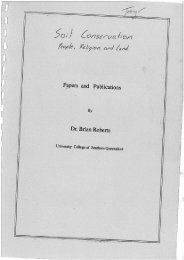western-queensland-gardening-guide.pdf - South West NRM
western-queensland-gardening-guide.pdf - South West NRM
western-queensland-gardening-guide.pdf - South West NRM
You also want an ePaper? Increase the reach of your titles
YUMPU automatically turns print PDFs into web optimized ePapers that Google loves.
Chapter 6. Common pests and diseases of horticul<br />
in <strong>western</strong> Queensland<br />
There are many diseases and pests whch attack horticultural crops. Adequate control<br />
may be obtained by carrying out correct cultural practices and by a few established<br />
pest and disease control procedures.<br />
Good <strong>gardening</strong> practices reduce pest problems<br />
It is no accident that pest and disease problems are usually less severe in neat nurseries<br />
or gardens than in unkept ones. The chances of pests and disease attacking<br />
horticultural plants are reduced when the surrounding area is clean and in good order.<br />
Weeds not only compete with the crop for moisture and nutrients, but provide cover<br />
for pests and diseases. Diseased plants should not be dug into the soil or left to lie in<br />
the area, but should be burnt to destroy the disease causing organisms.<br />
Chemicals are no remedy for poor cultural practices, and growers cannot hope to reap<br />
the full benefits from applied insecticides, fungicides or herbicides unless they practise<br />
correct cultural procedures.<br />
Lack of vigour because of low soil fertility is often associated with a disease outbreak.<br />
Attention should constantly be given to the provision of better soil fertility and<br />
improved soil structure for healthy plant growth. Practices which should be<br />
considered to help alleviate poor growth are:<br />
the addition of artificial fertiliser at planting time and in the spring<br />
the addition of animal manure or compost<br />
the building up of beds to give greater topsoil depth and better drainage.<br />
Other factors which may be the cause of lack of vigour include trace element<br />
deficiency, too much or too little moisture and nematode (eelworm) infestation.<br />
Crop rotation, that is, the planting of a succession of different types of crops, is a<br />
cultural practice which tends to prevent any undue increase in the pest and disease<br />
population associated with one particular crop. A two-year rotation will greatly assist<br />
in suppressing soil-borne disorders.
















